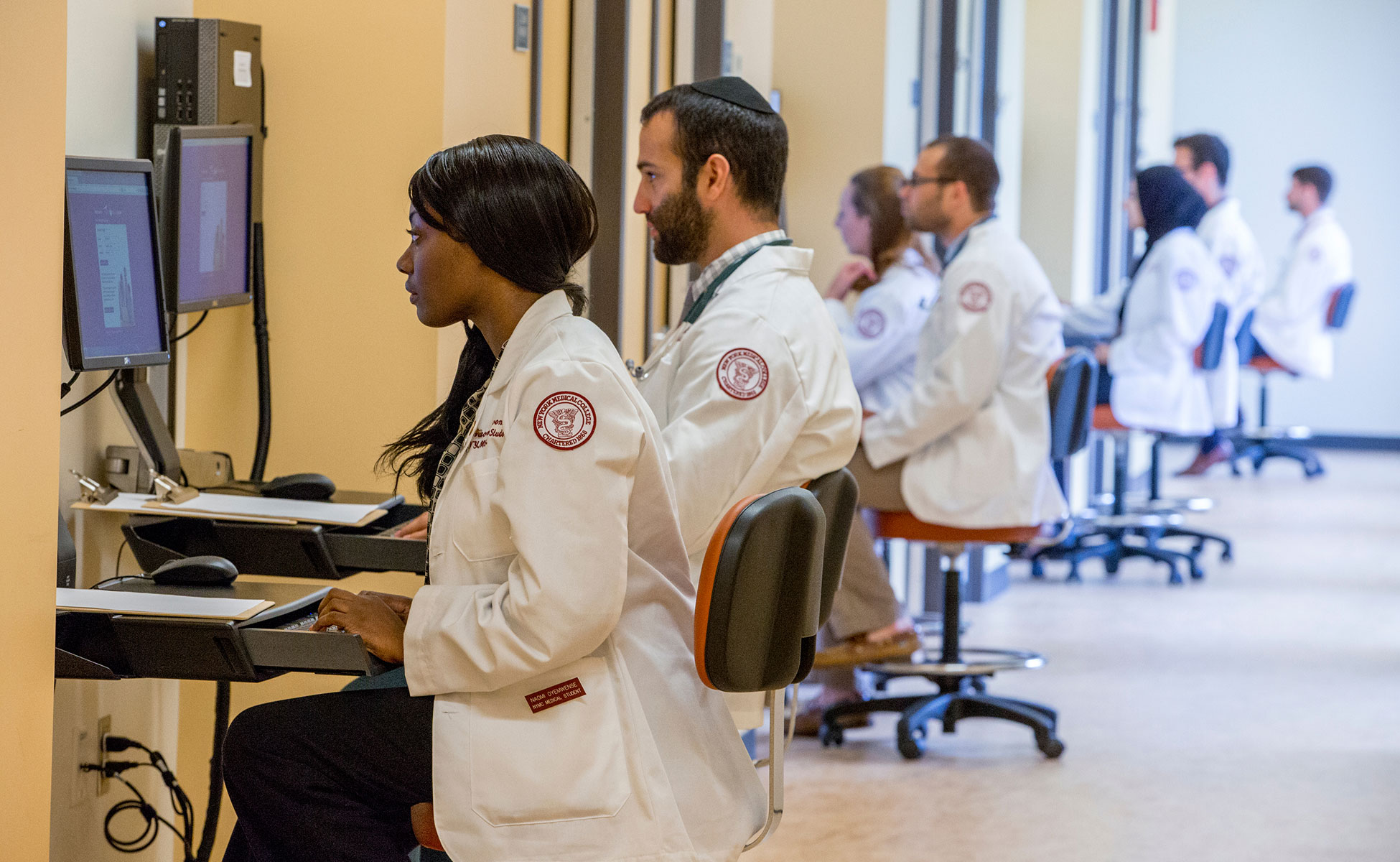During Phases Two and Three of the M.D. Program, you will spend the majority of your time immersed in complex medical practice settings at affiliated hospitals and ambulatory sites, supervised by our expert clinical faculty.
Our extensive affiliate network of hospitals, medical centers and ambulatory sites gives you the ability to interact with a broad range of patient populations in diverse healthcare settings. From Westchester Medical Center in Valhalla, N.Y., to NYC Health + Hospitals/Metropolitan in East Harlem to Yuma Regional Medical Center in Yuma, Arizona, our affiliated clinical network across seven states—New York, New Jersey, Connecticut, Rhode Island, West Virginia, Arizona, and Florida—will provide you with a rich diversity of unparalleled patient interactions.
Phase Two / Core Clerkships
This phase of the curriculum begins with the Transition to Clerkships course. This course is designed to frame the students’ transition from the pre-clerkship phase of the curriculum to the full-time clinical practice requirements of Phase Two. The course includes problem-solving sessions and training in advanced communication skills, procedural skills, and interprofessional teamwork to instill confidence and build competence for clerkships.
Transition to Clerkships (UMDM 3101)
To optimally prepare students to enter clerkship training, all medical students are required to participate in a Transition to Clerkship Course. This course facilitates the transition into the clinical realm with simulation-based procedural skills training, communication skills training with standardized patients, and small and large group didactic sessions to review critical concepts in Professionalism, Patient Safety, and Medical Errors, and Health Systems.
During clerkships, you’ll function as a member of an interprofessional clinical team of attending physicians, residents, interns, nurses and allied health professionals. You’ll have many opportunities to apply what you’ve learned in the classroom through supervised patient care, conferences, feedback and teaching rounds. You’ll broaden your knowledge of the clinical manifestations of disease processes, and continue to develop your interviewing and physical examination techniques and communication skills. Under supervision, you will begin to assume responsibility for the evaluation and treatment of patients. Through these experiences, you’ll also begin to learn what area of medicine you’re most interested in. With supportive and insightful mentorship, you’ll gain valuable practice skills to become a competent and compassionate health care provider.
PHASE TWO CLERKSHIP ROTATIONS INCLUDE:
This discipline explores biochemical processes and understanding of the life sciences at the molecular level.
- Internal Medicine (6 weeks)
- Neurology and Rehabilitation Medicine (4 weeks)
- Psychiatry (4 weeks)
- Obstetrics and Gynecology (6 weeks)
- Family Medicine (4 weeks)
- Pediatrics (6 weeks)
- Surgery (6 weeks)
Phase Three / Advanced Practice
The Phase Three curriculum is organized into specialty tracks to allow you to align your study with your area of interest to ensure maximum preparation for residency training. Beginning at the end of your third year, you will build on the clinical experiences you gained during your core clerkships and will have the opportunity to begin to function as an intern, but with closer supervision.
You’ll start and end Phase Three with transition courses, beginning with a course to transition to advanced practice and ending with a course to help you transition to residency.
Transition to Fourth Year (UMDM 3103)
The goal of the Transition to Fourth Year course is to prepare students for the increasing responsibility they will experience as fourth-year medical students. Students will gain knowledge and skills related to working and collaborating on health care teams, giving and receiving patient handoffs effectively and preventing and evaluating medical errors. Content is delivered through both large-group didactic sessions and small-group workshops and simulation activities. Additional sessions focus on professional development, Step 2 preparation and the residency application process.
Transition to Residency (UMDM 4301)
The one-week Transition to Residency program is an interactive “capstone” course that facilitates a student’s transition from medical school into specialized residency programs. During this course, students are organized into specialty tracks and engage in simulation-based procedural skills and hand-off training, evaluation and management of a critically ill patient, case-based problem-solving sessions and group didactic sessions to review strategies to enhance professional development and preparedness for residency training.
Specialty Tracks:
- Emergency Medicine
- Family Medicine
- General Surgery
- Internal Medicine
- Neurosurgery
- Obstetrics and Gynecology
- Orthopedic Surgery
- Pathology
- Pediatrics
- Psychiatry
- Radiology
- Undecided
PHASE THREE REQUIREMENTS:
There are two required rotations in each track. One is a sub-internship (subi) based on your track in one of the following:
- Internal Medicine
- Emergency Medicine
- Obstetrics and Gynecology
- Surgery
- Pediatrics
- Neurosurgery
- Orthopedics
And depending on your specialty track, a selective in one of the following:
- Emergency Medicine
- Radiology and Diagnostic Medicine
- Critical Care
- Pathology
- Psychiatry
You’ll take an additional seven electives, for a total of nine clerkship rotations. The rotations, along with your transition courses, will total 37 curricular weeks. You can choose from a wide variety of clinical electives spanning many disciplines, online electives, and research.


